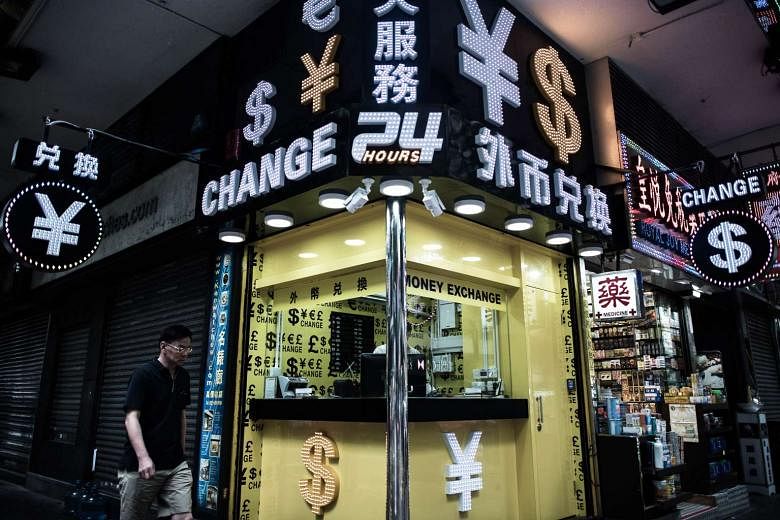NEW YORK (BLOOMBERG) - Currency managers won't be leading New Year celebrations after foreign-exchange funds suffered their worst year since 2011 as bets on monetary-policy divergence disappointed.
A Parker Global Strategies index that tracks top funds in the industry lost 2.4 per cent this year after the US Federal Reserve failed to raise interest rates as soon as some traders expected. Currency strategies that seek to benefit from rate differentials - known as carry trades - lost the most in seven years, a Deutsche Bank measure shows.
After a promising start to the year, with returns basking in their longest streak of monthly advances since at least 2003, gains tailed off as the Fed tied rate increases to economic improvement amid signs of a patchy recovery. That sapped momentum from the US dollar and investors turned instead to emerging-market currencies and those of commodity exporters, only to be slammed by a perfect storm of falling oil prices and increased volatility.
"When you're in foreign exchange, it's not for the faint of heart - you've got to like roller coasters and if you don't like roller coasters, you're in the wrong business," said Paresh Upadhyaya, director of currency strategy in Boston at Pioneer Investments, which oversees about US$241 billion. "People had very high expectations that the Fed was going to begin the tightening cycle, which really didn't happen for many, many months."
Pioneer remained profitable with its foreign-exchange positions by staying the course with its core bet on US dollar strength, Mr Upadhyaya said. The Bloomberg Dollar Spot Index, which tracks the US currency versus 10 peers, has gained 8.9 per cent this year.
The second quarter proved to be most currency funds' undoing. Managers lost 3.8 per cent in the period from April through June, according to the Parker index, the worst in data going back 12 years.
Investors preparing for the Fed's first rate increase since 2006 were blindsided when the central bank instead downgraded its predictions for US growth and inflation in March, sparking a dollar selloff as hedge funds and other large speculations cut near-record wagers on dollar strength.
Reluctance to return to that trade as the Fed shunned a rate increase in both June and September fueled a search for yield elsewhere, with investors borrowing in countries with low interest rates to invest in higher-yielding currencies. These so-called carry trades imploded as oil, a core export for developing economies, fell to the lowest in more than a decade.
Traders who used the yen to buy its 16 major peers lost money on 14 of those trades during the past 12 months. Eighteen of 22 emerging-market currencies used for carry trades failed to profit versus the Japanese currency over the same period.
"People have made money in the past with that strategy and they probably thought that the Fed wasn't going to be so aggressively hiking," said Manuel Mejia-Aoun, chief investment officer at Alpha4x Asset Management. "The problem is that when a currency moves 1 per cent a day, it's very difficult to make money."
Alpha4x's Capital Growth Fund profited from bets against high-yielders such as the Brazilian real, South African rand and Turkish lira, Mr Mejia-Aoun said. Volatility erased short-term gains for those who took the other side of those transactions.
Currency-price swings averaged more in 2015 than in any of the previous three years, a JPMorgan Chase & Co gauge of global currency volatility shows. Price swings were at their most severe surrounding central bank decisions, such as the Swiss National Bank removing the franc's peg to the euro, China devaluing the yuan, or the Fed debating higher rates.
"What you're seeing is volatility really spike up for these events, and everything else is just quiet and no one wants to invest," said Peter Gorra, head of foreign-exchange trading in New York at BNP Paribas SA.
Steering clear of the worst effects of that volatility was crucial to managers' success, with strategies that relied on momentum or valuation both returning a profit. Investors that identified and followed trends booked a 4.3 per cent gain, while those that bought currencies with the lowest purchasing power made 2.7 per cent, according to Deutsche Bank indexes.
For carry aficionados, there's always next year. With the Fed planning to raise borrowing costs as many as four times in 2016, yield differentials and the carry trade will remain in focus, according to Harmonic Capital Partners, which managed more than US$1.6 billion of assets as of the end of August.
"You're starting to see more potential for yield divergence than we've seen over recent years, so that's brought people back into considering carry as a trading strategy, but this year was probably too early," said Samir Sheldenkar, an investment partner at the London-based hedge fund. "If you are able to pick up on those divergences, I think it should be actually a good environment for trading foreign exchange."

